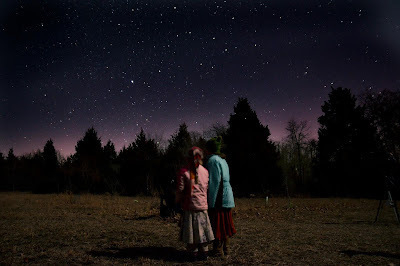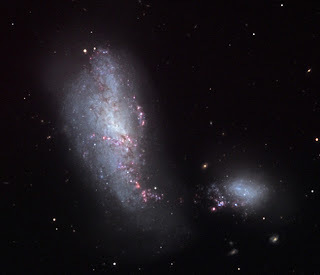Astronomy
- Fighting for funding in Congress
- Developing new technologies to deflect asteroids
- Hunting for Earth-like planets
- Searching for intelligent life in the Universe
- Creating a global network of EarthDials
- And flying our very own solar sail spacecraft, Lightsail-1.
Supernova!
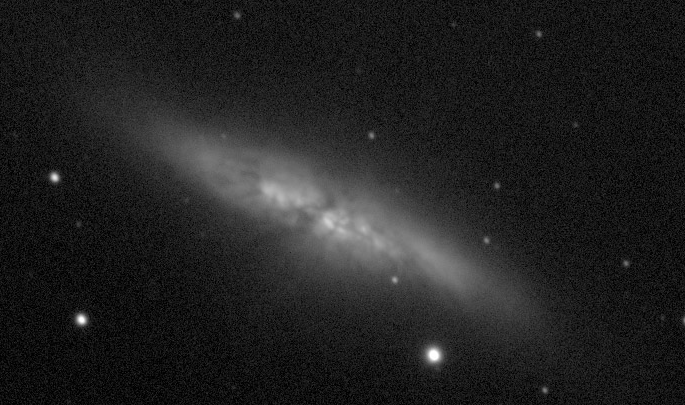 |
| Animation showing SN 2014J |
Around January 19th a new supernova was detected in the night sky. Dubbed SN 2014J, the supernova is visible from the northern hemisphere in M82, a galaxy in the constellation Ursa Major. Consider, M82 is 12 million light years away so this explosion actually happened 12 million years ago but it has taken the light that long to travel the distance between our galaxies. 12 million years ago our Earth was in what is now called the Serravallian stage of the Miocene geological epoch. While humans did not yet exist at the time of the explosion the Earth was populated by a diversity of life including apes which were widespread.
I set out to observe the new-to-us supernova the first clear night after it's announcement. I've looked at M82, also called Bode's Nebulae or the Cigar Galaxy, many times. It's one of my favorites and I am familiar with it. It is an elongated galaxy with more visual definition than most galaxies. In dark skies with a telescope of 8" or greater it is possible to see the mottling of dust and gas. I saw the supernova immediately as it appeared to be a tiny star in the lower part of the galaxy. To a casual observer it would not appear to be much other than a small and faint star not unlike many of the smaller and fainter stars in our own Milky Way galaxy. But this is not a star in our galaxy.
Let me offer some perspective. Our Milky Way is an estimated 100,000 light years in diameter. Most of the stars we see with the unaided eye are 10,000 light years or less in distance. The most distant we can see unaided is about 15,000 light years away. Most of what we see is a good deal closer than that. Now, to reiterate, this supernova is 12 MILLION light years away and yet we can see it as a distinct point of light. That must have been one magnificent event and when it happend humans did not yet exist on Earth. But our curious species does exist today and we have been around long enough that we have telescopes to observe as well as the science needed to understand it. When the light from this event reached us we were ready for it.
Astronomers classify this kind of supernova as a type Ia. Essentially, when stars the size of our sun have exhausted their hydrogen and helium fuel (after 10 billion years or so) they collapse in on themselves to something much smaller and more dense. We call this kind of collapsed star a white dwarf and they have a mass comparable to that of the Sun, but a volume comparable to that of the Earth. At this point the star is no longer undergoing the nuclear fusion of gas but is just radiating lots of heat into space and will do so for trillions of years. However, if the white dwarf had a companion star it might, thanks to gravitation, begin pulling off gas from that star. If this goes on long enough the white dwarf will form an accretion disk of gas around itself and as the gas accumulates it builds in pressure and density due to the increasing weight which raises the temperature of the core. When the star nears a size of about 1.44 solar masses a period of convection begins and then ignition. Because white dwarfs do not regulate the fusion process as normal stars do, ignition results in runaway fusion reaction. Much more detail about the process is available via this page at Wikipedia.
Tucker Creek Observatory Update!
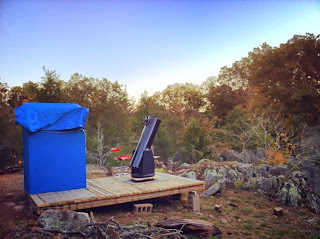 |
| The deck, Tardis telescope shed and scope all in place and ready for a night of viewing! |
Carl's Birthday
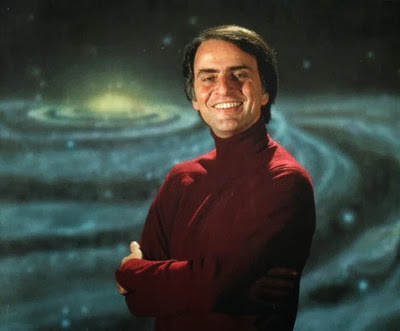
Yesterday was Carl Sagan’s birthday. I really should have celebrated with a night of star gazing but I was exhausted from a full day and a full week so I stayed inside. It seems fitting though that sometime around 3 am I awoke with thoughts of Carl, the Universe and my place in it. As my mind often does at those early hours (If I’ve been asleep in bed but stir from slumber) I began mulling over a variety of thoughts. Perhaps that’s why long nights at the telescope with views of distant galaxies or Milky Way globular clusters and nebulae are often such an interesting exercise in quiet contemplation. In any case, I was awake and pondering some time outside under the stars. Laying next to Kaleesha I caressed her neck, her back and her hips enjoying the warm coziness of the moment and her sweet sighs as she stirred to my touch. After a little while I decided I would get an early start to the day with a view of the stars, planets and the sunrise.
I layered up with clothes and ventured outside with my iPad and quietly walked up the hill with Murphy at my side. There’s something entirely comfortable about walking up a woodland trail with the stars peeping through the breaks in the trees above and a big dog like Murphy keeping you company. The stars this morning were not a disappointment. They never are. The sky could not have been clearer and in this part of Missouri they are very dark. Orion took my breath away as it hovered in the southern sky. It is in moments such as this that I am overcome with a blissful mix of emotions and thoughts, feeling a joy of being connected to the Earth as I look up with an understanding that I am from the stars. That we, that all of this, is of a Universe which is bound together even as it is expanding further apart.
One of my thoughts this morning, in bed and now carried with me as I walked up the hill pertained to how it is that so much of our lives, in the America of 2013, are spent in pursuit of the next big thing and in particular, then next big shiny thing. Shiny things. It seems we modern humans, at least those of us who live in the “wealthy” nations, have become obsessed with trivial entertainments. From the Super Bowl to sitcoms to eating out to shopping, all the while dutifilly posting Facebook “Status” updates, we keep ourselves busy with our various forms of consumption and our “sharing” of it. How much of our mental and emotional energy is bound up in the aquisition of wealth and material objects. Bigger homes with nicer furnishings, name brand clothes covering overly cleaned and perfumed people driving new cars to jobs which may or may not be satisfying but which are required to maintain the lifestyle and the seeking of status that often comes with it. iPhones and iPads, texting while driving to the next afterschool sporting event, in the presence of others but rarely actually communicating with them.
This morning I think of Carl and his efforts to push humanity forward in its exploration of the Universe and it’s understanding of that Universe. I think of his warnings about our behaviour towards one another and towards the planet we share with not just other humans but with a great multitude of other species. I’ve spent most of my adult life concerned about problems such as climate change and have made a fairly consistent effort to communicate those concerns with others. I’ve made many of my life decisions based upon my understanding (limited though it is) of humanity’s effects on our planet and so this morning as I looked at our Milky Way neighbors I could not help but ponder Carl and what he sought to communicate.
If we humans are ever able to leave our planet for the purposes of living elsewhere it is a long way off. For the forseable future the Earth is our home and we are not doing a very good job of taking care of it. In this past year of looking up at the night sky I have, more than any other time of my life, come to appreciate the beatuy of the Universe. I have also developed a new-to-me understanding or perspective of our home planet in the context of the Universe. With each day the evidence grows that there are likely billions of planets in just our own Milky Way galaxy that might support life, planets that inhabit the “goldilocks” zone around their respective stars. There are billions of galaxies and, in light of these numbers, my doubt about life elsewhere in the Universe continues to shrink. And though we know that life on Earth has an expiration date based upon the life cycle of our sun I can’t help but wish that we humans might make the effort to live as though what we do matters. Perhaps our existence is meaningful because of this known expiration not in spite of it. Our species’ existence is likely to be ephemeral in the grand scheme of things but is that any reason to live without care?
Before the sun began to lighten the sky I pointed the telescope to the north, to Ursa Major and there I found the two galaxies, M81 and M82, collectively known as Bode’s Nebulae. The photons from these distant galaxies traveled for more than 12 million years before finding their way to my eyes. I spent a good long while looking at these two as they are fairly close and offer more detail than more distant galaxies. What life might exist there on the billions of planets that likely orbit billions of stars? Next I looked at Jupiter and then Mars, just a stone throw away by comparison. The sunlight reflected from these two planets traveled to us in just minutes. Current missions to Mars are looking for evidence of past life there. Jupiter’s moon Europa has an atmosphere which consists primarily of oxygen and a smooth icey surface which may well have liquid oceans beneath. Oceans that may support life. As the sun began to brighten the sky I aimed the telescope at the Orion Nebula for one last look.
After putting the scope away I stood for a few minutes on the soft layer of cedar mulch that covers the boulders that overlook the shut-ins of Tucker Creek. I spent a few minutes observing the rushing water and rich textures of the landscape. The trees of this south-facing hill are now nearly shed of all their leaves but are covered in thick layers of lichen. The rocks too are covered in patches of lichen and moss. Even in the chill of a fall morning life is abundant.
As I walked down the path, Murphy again at my side, I could not help but overflow with joy at the crunching of leaves underfoot and the gold light of our sun filtering through the mostly bare branches. There is something very enjoyable about acknowledging and being mindful of the sun not just as the sun but as OUR STAR. At the bottom of the hill our little homestead was stiring with the morning. Chickens, ducks and a goose were all awake and begining their business as were the goats. Soon I would sit in the warmth of the house and write at the kitchen table to the sounds of children pitterpattering above.
Tucker Creek Observatory - Night Shot
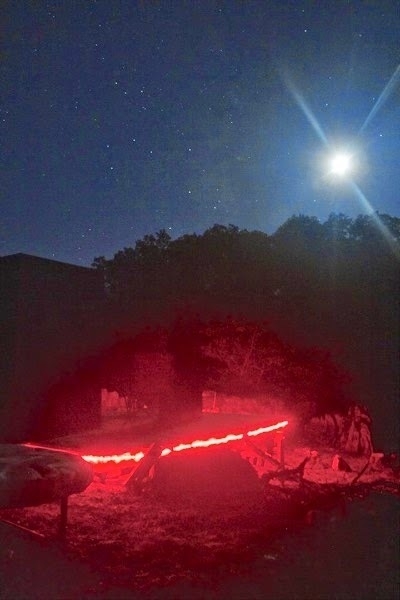 A time exposure so the amount of light from the red LEDs around the observing deck is exaggerated.. A beautiful view. Sagittarius is visible above the southern horizon, left of the moon.
A time exposure so the amount of light from the red LEDs around the observing deck is exaggerated.. A beautiful view. Sagittarius is visible above the southern horizon, left of the moon.
Tucker Creek Observatory
I've been here at Make-It-Do Farm for almost four months and I'm happy to say that we now have a fantastic observatory site. It took a bit of work but we got started a couple weeks ago cutting down a few trees. Most of them were cedars and not the healthiest trees so I don't feel too terrible for cutting them down. We've got a couple more on the north side to take down. As of now the view from the northwest all the way around to the northeast is pretty fantastic. We've got a great view of the southern horizon which allows for easy viewing of Sagitarius in the summer. When we're finished I expect that our view of the skies will be as clear as those I had at the lake but even better as the skies are even darker here! The observation deck is nearly finished and then I'll build the telescope shed.
In the few nights I had up on the hill before the moon and cloudy weather returned I had some fantastic views of the Ring Nebula, Andromeda, Perseus Double Cluster, Messier 2, Eagle Nebula and Lagoon Nebula. Quite a few others too but those are the highlights. Not only is the hill a great viewing site but it sits within just a hundred feet of the shut-ins of Tucker Creek. Just as the lake offered an amazing night-time symphony of geese and other life, so too does this site offer the sounds of frogs, insects and running water. The skyline is framed in trees and the rock bluffs all around are barely visible in the pale starlight. Beautiful. I didn't think I could have a better site than the lake but I think this is it.
How and why to record your astronomy observations
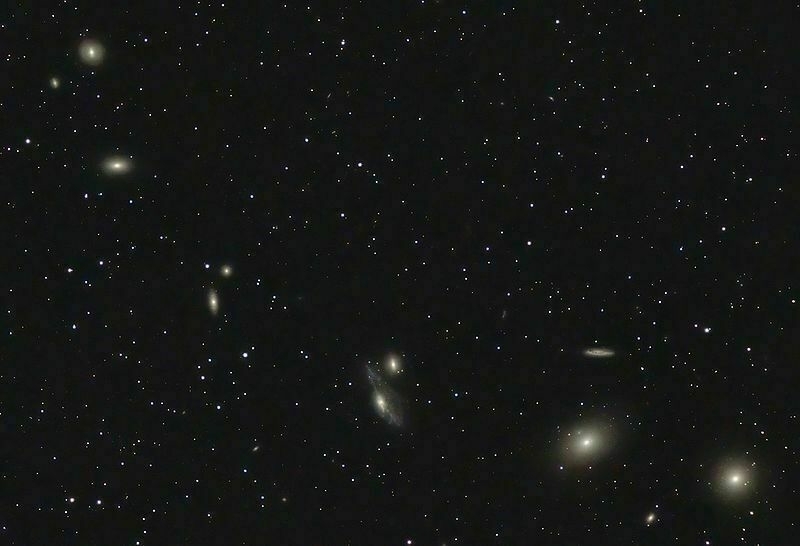 |
| M84 is the last, in the bottom right of this chain. M86 is the large, slightly oblong galaxy to the left of M84. |
In looking through the notes that I did record, starting sometime in November, I realize now what a poor job I was doing. I expect I may one day look back at my current notes and think the very same thing. Here's an example. For M84 my description was simply "A fantastic cluster of galaxies - beautiful." That's not the correct way to do it. For starters, M84 is a single galaxy that is a part of a string of galaxies called the Markarian Chain. It would have been fine for me to describe it as a part of that chain but I should have included a description of the object too. Probably something along the lines of "M84, a lenticular or elliptical galaxy, presents as a spherical halo with a stellar core." That is still a pretty basic description but it would be a step in the right direction. I could have added something about it's relationship to nearby M86, perhaps comparing the two and noting that M84 is more spherical with a slightly brighter core while M86 is slightly less bright with a more oblong shape. This is far more complete and will help me remember what it is I've seen.
As for the how of basic observation and recording, I use an iPad, spread sheet and database. Each observation gets logged into the spreadsheet on the iPad which is later entered into a FileMaker database. I record the date, time, atmospheric conditions, telescope used and eyepieces used. Lately I've also been recording temperature. Last is a brief 2-4 sentence description of the object and how it might appear in relation to other objects in the eyepiece. The more detail I can record the better I'll remember the observation when I read the description later. Also of great importance is that in recording observations, in looking for detail, we're actively training our eyes and brains to see better. The recording reinforces the observing skills and the increased observing skills, in turn, result in better written notes. One last thought, I also make it a point to at least skim the description of the object in Sky Safari as it often notes what should be visible in an amateur scope. I am also sure to study the image presented as a guide in observation of detail. The photos are far more detailed than what we can expect to see with our eyes but after a bit of practice I've learned to translate the images into more realistic expectations. They present the ideal of what is there.
Amateur astronomy, as I've written before, is a great way to learn some of the basic skills of science. Namely, the importance of consistent and methodical observation/data collection as well as consistent and methodical recording of that data. Amateur astronomers regularly contribute to the collection of data used in the field and with citizen science projects such as Zooniverse they are also helping to analyze the data collected by the many space telescopes currently collecting vast amounts of data. Whether they are finding NEOs (near earth objects such as asteroids) or finding exoplanets, amateurs are contributing to the science. It requires a certain level of observational skill, a willingness to increase that skill, and time. That's about it. Well, actually, it can be quite a bit more complicated and the time involved can be great if one is serious about certain areas such as the search for NEOs which requires not just detailed observation but consistent and methodical photography.
One last point. For anyone getting involved in amateur astronomy there is the side benefit of not only paying closer attention to what is being done by scientists in the field but also a very real-world personal benefit of a much deeper, more meaningful understanding of how science works generally and just how complicated the work really is. I can say that in just a few months my level of understanding, though still pretty basic, has been greatly increased and my appreciation for the work of NASA and others is now on an entirely different level.
Dark Skies to you!
Comets, Meteors, and Asteroids!
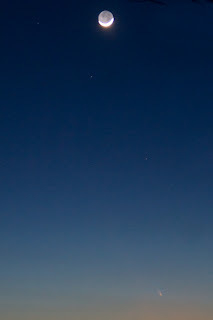 Winter is passing and I’m certainly looking forward to the spring!
Winter is passing and I’m certainly looking forward to the spring!
I’ve had some great viewing sessions since my last post just over a month ago. Mostly galaxies on my Herschel 400 list. I’ve now viewed 329 out of 400. On the Messier list I’ve got 107 out of 110. I’ll probably get the Messier completed sometime in April and the Herschel 400 sometime in May or June. I’ve just got to wait for the objects to become available in the sky again! Next on the list of observation programs: The Herschel II and the Lunar I program. There are 40+ programs offered by the Astro League. I’m looking forward to them!
Before I get into some of the Herschel highlights, I’ll note two very cool observations. Most recently, last night in fact, I got a look at Comet Panstarrs C/2011 L4. It is currently viewable just after sunset. I caught it at about 7:40pm halfway between the moon and horizon. Just barely visible to the naked eye, it is best viewed with binoculars or telescope. I had a very nice view of it with the 8" dobsonian. With the 30mm eyepiece the tail is nicely defined and the comet core is very bright! Photo was taken at ISO 800 at 85mm, about a 2 second exposure. Comet is in the bottom right. The moon was nicely lit with reflected light from the earth called earthshine. As of now the comet has completed its orbit around the sun and is moving back towards us and into its tail.
The second observation was that of the asteroid, 2012 DA14, that made a close flyby of the Earth on February 15th which by chance, was the day that a meteor exploded over Chelyabinsk, Russia. My observation of 2012 DA14 didn’t last long thanks to the clouds but I had it for five minutes or so… As expected, it looked like a faint, small, slightly fuzzy star slowly moving through the eyepiece. Pretty neat to observe it.

Another galaxy, viewed on March 7, was NGC 4565, The Needle Galaxy and this was quite stunning. Similar to NGC 4710, in that it is an edge-on spiral galaxy. It is about 30 to 50 million light-years away in the constellation Coma Berenices. It is a stunning object in the eye piece. What makes it nice to look at is that dark lane of light absorbing molecules that extends across it, blocking the light. A very nice detail that can also be observed in the Somrero galaxy, NGC 4594. The Bad Astronomer, Phil Plait has an excellent write up about on edge galaxies.
The Eastern Ozarks Astronomical Society continues to meet regularly to observe and we have also begun our efforts at community outreach. Hoping to have more to report on that soon. One last thing I’ll add and that is that there is so much happening right now in the field of astronomy. Between the Mars Curiosity discoveries as well as the many other discoveries concerning the Higgs Boson, exoplanets, it’s hard to keep up with it all!
Weeping to the Cosmos
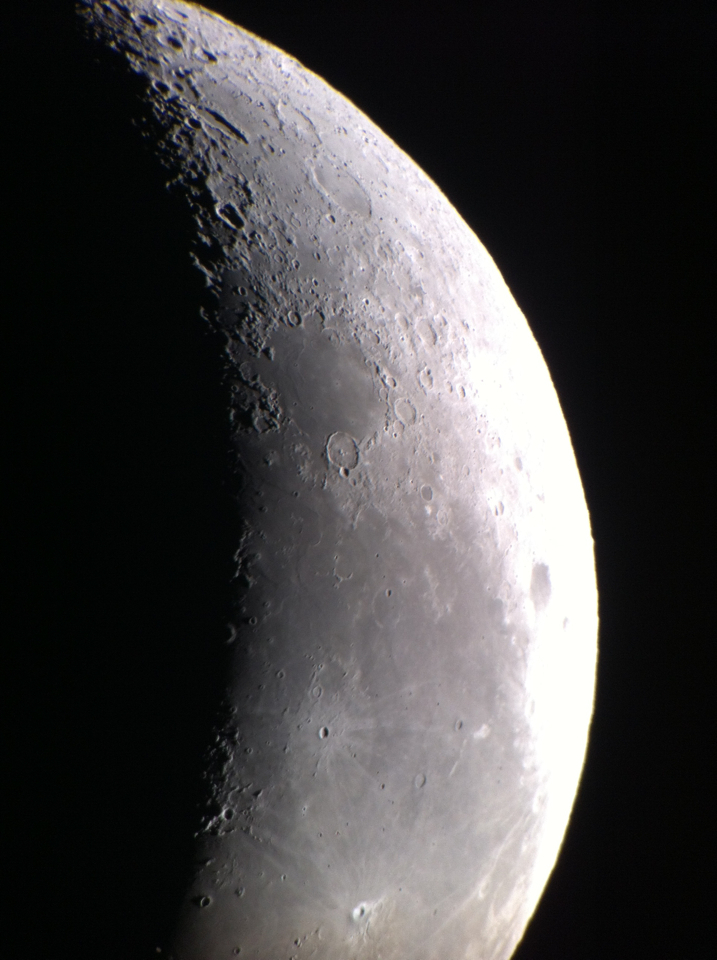
Moon photographed with iPhone and Z12, February 5, 2013
We had a fantastic night last night in our group observation for the Eastern Ozarks Astronomical Society. It was the usual crew plus a couple of newbies. Of course Russ and Karen were there. Kaleesha made it back for her third time at the scope and with her Blueberry and Seth. It was Seth’s first time and he took to the scope very naturally. Our new Farmington astronomer friend Mark made it for the second night in a row and though we were clouded out first night, last night we had perfect skies from sunset till sunrise. It’s always nice having new folks in attendance. We discussed open clusters, the use of the word nebula in the initial naming of galaxies which, at the time, were not known to be galaxies! We also went over star hopping with the 8" dobsonian with a red dot finder and folks got a chance to find a few Messier objects. Lots of fun! We also saw a very nice green fireball!
After most folks left Russ and I had an excellent conversation about the scientific method and the importance of skepticism. After that I took a brief dinner break and then set back out for some solo galaxy observations from my Herschel 400 list.
After about six galaxies I took a break to just look up with my eyes and the beauty of it was just too much. I suppose all there is to say about it is that I cried and I kept on crying. I thought I’d finished and then I cried more. No doubt, a part of what was going on was that I’d set a particular song on repeat, The Cinematic Orchestra’s song To Build a Home and I’m fairly certain that it was the song, combined with what I was seeing, that sent me over the edge. To be honest there have been several such moments during my nights at the scope over the past few months. I’m usually able to control it but sometimes it is good to just let go and accept it.
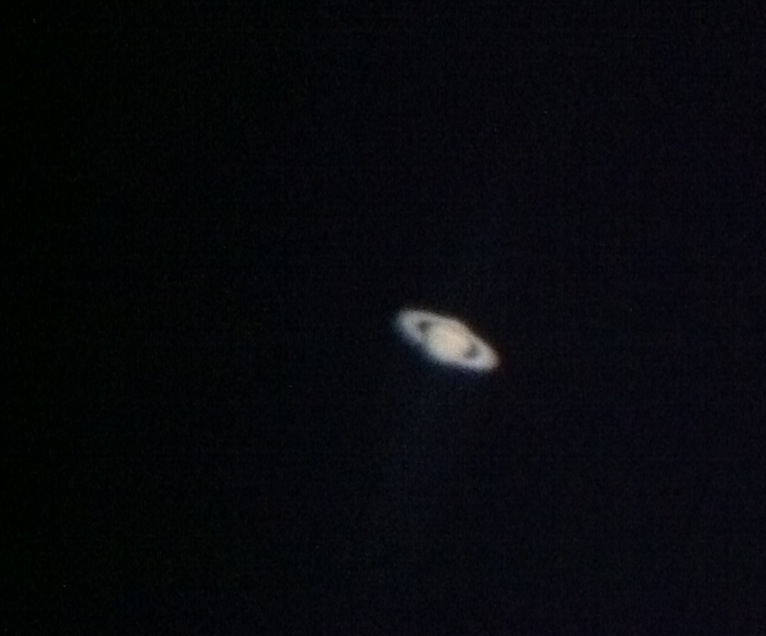 Saturn photographed with iPhone and Z12, February 5, 2013
Saturn photographed with iPhone and Z12, February 5, 2013
It’s not the first time I’ve had the sensation, a sort of heightened alertness and emotional intensity that just comes in like a slow motion wave. Usually it’s just the result of really being in the moment, be it under the night sky looking at stars or standing in the cold watching my breath seemingly frozen midair or any number of other similar moments. It is as if time slows down and in those moments I am not just seeing what’s around me, but being in what is around me. To put it simply, it seems like a convergence of emotion and intellect that results in something not quite our normal day-to-day experience, something overwhelming.
I’m guessing most people have these moments at various times in their lives… I certainly hope so. I’ve mentioned to a few folks recently that I feel like, more often than not, I exist in this sort of low level bliss. In part I think it comes with this kind of simple life. I own so little and live in such a small space that my life is not about owning but about being, about experiencing… searching and exploring. Our lives are short and so it makes sense to me to live it as my life but to do so in constant connection and ever deepening relation. I made a choice to never have children so being connected means something different for me. It’s frogs and stars, geese and planets, friends and family, it is belonging to life and to the earth and to this cosmos. When you belong you are free.
Eastern Ozarks Astronomical Society Updates!
EOAS member Corey Warner of Studio 222 designed a fantastic logo for us and Karen Whitener was interviewed, for J-98, for one of the regional radio stations which will be airing the spot several times so that will help get the word out as well. Thanks to Scott Kubala of J-98 for taking an interest in our project. I also set up the Eastern Ozarks Astronomical Society website to seal the deal!
We've got many evenings ahead of us and I expect that they will each be filled with the joy that seems to come with the shared exploration of the universe. Dark Skies!
Exploring the Universe Together
 |
| NGC 4594, the Sombrero Galaxy |
What I enjoy most about being an amateur astronomer is learning about the Universe through a blended process of observing distant objects and then reading about those objects in the Wikipedia which is usually supplemented by a related episode of Astronomy Cast. It adds so much to my life to be able to look up through a telescope and view the Sombrero galaxy, to really take it in and ponder its existence. I wonder, who may be there and are they looking out in this direction? In my last viewing of that galaxy I spent nearly 30 minutes allowing my eyes to adjust and taking the time to notice the details. After a time of looking through the scope and seeing so many beautiful objects, supplemented by the research, I can say that now when I look up with my naked eyes I see it all very differently. There is now a deeper awareness brewing in me, fermenting knowledge, of the details and I more fully appreciate what I see and the emotions I experience as a result.
But of course we don't explore this Universe alone do we? At the forefront we have a global community of scientists cooperating and collaborating and challenging one another through this amazing process we call science. This open community, based on finding the mistakes and correcting the theories and adding in the details as they are discovered with newer, better instrumentation, sets the example for how we can better get at the truth. It is a never ending process, an ongoing adventure and exploration of our Universe and one we can all take part in. Those of us that are not scientists have a role as well.
As citizens of our planet it is our responsibility to make our own effort to learn and to explore. It is our responsibility to reach out, to share and engage with one another and with the knowledge being produced. The internet is allowing for increased communication between the public and the scientific community. For those interested in astronomy and related fields there are the sites I mentioned a couple days ago: CosmoQuest, the Planetary Society and the Citizen Science Alliance, all of which have at their core mission an attempt to engage the public and even to create a space for them to participate. Most of these groups are also involved with Google+ hangouts which allow for real-time video conferencing with the scientists doing the work. If you can't be around to watch live they are all archived on YouTube. For example, here's the Planetary Society's Channel.
There is an essential trait that we need to borrow from the scientific community before we can move forward: a willingness to embrace our mistakes and our ignorance. It seems to have become a common cultural trait to fear our fallibility but such fear holds us back from moving forward as individuals as well as collectively. Not so in the scientific community which is based upon a willingness to fail and a recognition that with failure comes knowledge and a better understanding of the Universe. It is in the moment of embracing failure, mistakes, and ignorance that we grow.
It is perhaps one of the great failings of the past 60 years that we have come to think of ourselves as alone and with that we have come to feel isolated, alienated. In that kind of world it is easy to become fearful and when we live in a culture of fear and insecurity we tend to avoid failure. We avoid growth out of fear of failure and we avoid accepting our mistakes because to do so is to admit we are fallible.
Fortunately, for us, the Universe that we actually inhabit is not one in which we can ever be alone or alienated, at least not physically. We might come to feel separated and alone in our minds due to our perception and our culture, but as far as the reality of the physical Universe that we live in, we are all very much connected:
When I look up at the night sky and I know that, yes, we are part of this Universe, we are in this Universe, but perhaps more important than most of those facts is that the Universe is in us. When I reflect on that fact, I look up — many people feel small, because they’re small, the Universe is big — but I feel big, because my atoms came from those stars. There’s a level of connectivity — that’s really what you want in life. You want to feel connected, you want to feel relevant. You want to feel like you’re a participant in the goings on and activities and events around you. That’s precisely what we are, just by being alive.” - Neil DeGrasse TysonIt is natural for us to share what we know or think we know and it is natural for us to be curious. It is these natural desires, coupled with critical thought and the scientific method that we can lift ourselves up and, just as importantly, lift one another up. We have great challenges before us but in teaching one another and encouraging one another we can do remarkable things. In our cooperation we have the opportunity to co-create something beautiful: each other.
We truly are in this together. There is no such thing as alone in this Universe and the sooner we remember that, feel that, and understand that, the sooner we can get on being whole again. We are but one species sharing this planet sharing this cosmos. I did not know Kaleesha or her husband or children until just a couple months ago and am thankful to Bill (another of our community and local librarian) for sending them my way when they indicated interest in astronomy. As a result they have become an important part of our little outpost of science advocates in this out of the way rural community. As long as I'm expressing my appreciation I think I'll also mention how happy I am to have connected to Frances, Russ, Angie and Karen, all humans with which I am grateful to have met since moving to this little corner of the Universe and who have shared the exploration with me.
Eastern Ozarks Astronomy Society First Night!
My friend Russ Middleton got some great photos and one of our new members, Kaleesha, and her girls had a look at a nice variety of nebulae: Orion, Pac Man, Eskimo and M1, the Crab. We also took a look at Jupiter and ended the group viewing with Bode's Nebulae, M81 and M82. Lots of great astronomy talk about the Cosmic Microwave Background, the Bing Bang, and how astronomers (and science in general) come to know things through the scientific method.
After everyone left I warmed up inside for a couple hours and went back out after the moon set. I logged 13 galaxies, a planetary nebula and a globular cluster, M68. Five of those were Messiers bringing my total on that list to 103, just 7 more to go! Messier 104, the Sombrero, was really impressive and with averted vision I was able to make out the dust lane. M68, was really beautiful with many of its stars nicely resolved. I also added nine more to my list of viewed Herschels, bringing me up to 241 out of 400.
The last object viewed from 4:20-5am was Saturn. This was, by far, the best view of the planet I've ever had in my life and honestly, I think I could have cried but it would have ruined the view so I didn't let it happen. It was so otherworldly, and yet, so familiar an image. Viewing Saturn is always special but when it is so perfectly clear, it can be much more.
I saw at least 5 of the moons as well as the Cassini Division in the rings, a first for me. Also saw clouds/color bands, another first for me. Sometimes language fails me.
I can think of no better way to spend a night than this.
Advocating for Science Literacy and Reason
I’ve always been a big fan of getting at the truth of things no matter how inconvenient or uncomfortable we may be getting there. It’s something I’ve insisted on and many times in my life it has caused me a good bit of trouble. That said, I don’t feel I have much choice in the matter. It’s the activist and the radical in me. It is, perhaps sad, that insisting on the truth might, today, be considered radical. I suppose when you look at the definition of “radical” it does speak to the search for truth. According to the New Oxford American dictionary, radical is: “relating to or affecting the fundamental nature of something; far-reaching or thorough.”
In recent months my small town life got a bit rough in terms of some of my relationships. Specifically, those relationships which I’d developed with local conservatives. It was my intent to cross lines, to try to relate to my fellow humans as humans regardless of their political or cultural leanings. As a result, I’d gotten to be “friends” with quite a few folks that I tended not to agree with on many things. They knew and I knew those differences existed but we made a go of it. But eventually those differences presented themselves front and center and some of those friendships ended in turmoil.
What I am coming face to face with in rural Missouri is the hard truth that many rural residents are not comfortable with having their beliefs challenged, most notably their religious beliefs. Some are able to co-exist with science and accept the possibility that their belief in a higher power can be retained along with an acceptance of science. Others don’t seem able to bridge the gap but tend to remain neutral. Some are resistant to the point of hostility.
I have pondering for some time what seems to be an innate tension that exists between religion and science. This is a very real and very serious problem and manifests itself in important and basic elements of science education, namely the teaching of the Big Bang, evolution and climate science. Creationism and intelligent design (a version of creationism promoted by the Discovery Institute) are not, in any way, valid alternatives to evolution. Nor does the fundamentalist Christian community provide any kind of explanation or description of the origin of the universe and yet, they have established an influence in public education on this as well. While the U.S. has downgraded and simplified math and science education other countries are making great progress.
My intent here is to explicitly advocate for science literacy and reason. Evolution, the Big Bang, climate change are all areas of science that have been, to a great degree, settled. While there are many in this and other rural areas who do understand the importance of science as a method for understanding the world and as a basis of progress, there are many who do not. A part of the problem comes from the churches, from organized religion who are crossing lines in terms of social and political advocacy which cannot be tolerated. Another part of the problem is the confused and sloppy thinking that comes from religious belief. I would argue that religion, as it is based on faith, actually requires a level of rejection of reason and the scientific method. At the core, science is the search for truth while religion is advocacy of a belief in something that can never be shown to be true.
I’d like to explicitly support a few organizations that are doing important work that you can support and in some cases actually participate in via citizen science projects.
CosmoQuest is one of my favorites. From their website:
Another is the National Center for Science Education.Our goal is to create a community of people bent on together advancing our understanding of the universe; a community of people who are participating in doing science, who can explain why what they do matters, and what questions they are helping to answer. We want to create a community, and here is where we invite all of you to be a part of what we’re doing.There are lots of ways to get involved: You can contribute to science, take a class, join a conversation, or just help us spread the word by sharing about us on social media sites.Like every community, we are constantly changing to reflect our members. This website will constantly be growing and adding new features. Overtime, we’re going to bring together all the components of a research learning environment (aka grad school), from content in the form of classes, resources, and a blog, to research in the form of citizen science, to social engagement through a forum, social media, and real world activities.
The National Center for Science Education (NCSE) is a not-for-profit, membership organization providing information and resources for schools, parents, and concerned citizens working to keep evolution and climate science in public school science education. We educate the press and public about the scientific and educational aspects of controversies surrounding the teaching of evolution and climate change, and supply needed information and advice to defend good science education at local, state, and national levels. Our 4500 members are scientists, teachers, clergy, and citizens with diverse religious and political affiliations.
Last but not least is The Planetary Society, co-founded by Carl Sagan and currently headed by Bill Nigh.
The Planetary Society sponsors projects that will seed innovative space technologies, nurture creative young minds, and be a vital advocate for our future in space.
Why we do it
Our Mission is to create a better future by exploring other worlds and understanding our own.
Current projects include:
Interested in getting your hands dirty with some citizen science? Of course you are! Check out the Zooniverse which is a project of the Citizen Science Alliance.
OriginMy favorite thus far is Planet Hunters which I have participating in. It’s very easy and exciting to know that I’m actually doing some of the preliminary work required to find planets around distant stars.
The Zooniverse began with a single project, Galaxy Zoo , which was launched in July 2007. The Galaxy Zoo team had expected a fairly quiet life, but were overwhelmed and overawed by the response to the project. Once they’d recovered from their server buckling under the strain, they set about planning the future!
Galaxy Zoo was important because not only was it incredibly popular, but it produced many unique scientific results, ranging from individual, serendipitous discoveries to those using classifications that depend on the input of everyone who’s visited the site. This commitment to producing real research - so that you know that we’re not wasting your time - is at the heart of everything we do.
Real Science Online
The Zooniverse and the suite of projects it contains is produced, maintained and developed by the Citizen Science Alliance. The member institutions of the CSA work with many academic and other partners around the world to produce projects that use the efforts and ability of volunteers to help scientists and researchers deal with the flood of data that confronts them.
Of course there are others but these are the ones I wanted to mention today.
Second night with the Z12
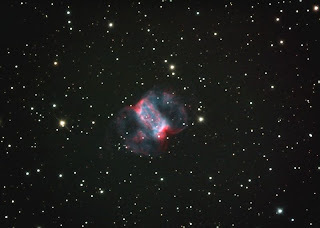 |
| Little Dumbbell |
There were several nice open clusters in the constellation Monocerus and a whole slew of galaxies in Leo. 14 objects knocked off my Herschel 400 list plus just for fun looks at Andromeda, Jupiter and the Orion Nebula. Almost 7 hours, 21 degrees when I came inside and started a fire at 2am! A great night!
12" Zhumell Dobsonian Review and First Light
 |
| Pardon the rope, the Telrad was not permanently attached at the time fo the photo! |
The scope arrived in good shape in undamaged boxes. I had it put together in an hour and that was taking my time. This is a huge scope for one person to safely maneuver. I'll be happy to have it in a permanent location with shed that will get rolled back during use.
Collimation before first light was a bit tricky. I'd read that the laser collimators that ship with these are out of collimation themselves and are of no use until they are collimated first. I set about doing that but adjustment screws are of a size (allen wrench) I do not have. Luckily my observing buddy Russ had his. Getting the secondary aligned was easy enough. The primary mirror, on the other hand, not so much. It seems that the tension springs in the adjustment bolts are pretty weak. As I turned them this way and that it became clear that I was going to have a hard time getting the mirror where it needed to go. Then it occurred to me that the lock screws, while not intended for adjustment, often do effect the mirror when tightened down so I tried turning a them a bit and presto, I had a collimated mirror.
This is a big mirror that will often need cooling down which is why they include a fan. I have not used it yet because I had it out in the shade on the first day and in the well house the second day so it was cooled off and ready to go at dark.
A few words about the hardware on the scope before I delve into what I saw with it. Everything seems very solid. I've not used the finder scope yet because I ordered a Telrad and have used it both nights. That said, the finder seems decent in terms of construction. The big plastic cover for the OTA (optical tube assembly) is a pretty loose fit so I'll have to do something about that. Of course the stand is particle board like all of these mass production units but seems solid enough for now. Movement of the scope is very smooth and it is very well balanced. I WILL upgrade to a home built birch plywood stand at some point. All in all, the scope seems very well built. I've encountered no problem other than the above mentioned weak tension springs on the collimation screws that I'll replace and the loose cover. As you can see from the photo, this is a huge scope and not something I want to move much.
The dual-speed Crayford focuser is very smooth and a nice upgrade over the focuser on the XT8. Being able to fine tune the adjustment is a very nice benefit of this focuser.
First Light for the new scope was Friday night and it was perfectly clear for it! My intent was to spend some time just getting familiar with the bigger scope and compare some of the views with what I've seen with the 8". There's no doubt it is impressive.
First object viewed was Jupiter and it looked great. The main difference, given good seeing conditions, is a sharper image. The 8" struggles with the 5mm EP but provides a fairly crisp image with really good seeing conditions. The 12" provides an even sharper image with a few more details in the cloud bands and also seems to have a little more tolerance of poorer conditions though I won't know for certain until I've used it more. Of course the same eyepieces also provide higher magnification due to the different focal length. The 5mm needed for detailed planetary viewing gives me 240x in 8", but 300x in the 12". So, not only is it a sharper image but it is also more magnified. Even better, I could, push it to even higher magnification if given the right eyepieces/barlow whereas 240x is the upward limit for the 8".
Next up for comparison was M31, M32, M110: The Andromeda Galaxy and it's satellites. This is a big and very bright object so what I was hoping for was some detail. With the 8" I get a big and beautiful view but no detail. With the 12" I am seeing some structure. It is especially noticeable with the 11mm Explore Scientific 82 degree (provides a wider field of view than standard lenses). At that level of magnification I am seeing a smaller picture but I do see the dust lanes which I don't think I'm seeing at lower magnification. In all the EPs the 3 objects are beautiful and the more faint M110 is much more defined and easy to see.
Next on the list, the Orion Nebula which never disappoints! In the 8" the nebula presents a fantastic view and in the 12" it is a fantastic view. More detail is visible and some of the dark areas are more pronounced. I'll have to spend more time observing before I can offer any more detail.
Now we are getting closer to those things which I expect will really benefit from the 12". Specifically, globular clusters, faint nebula, and distant galaxies. A great example would be something like NGC 2158 which is very rich open cluster in Gemini which almost seems like a loose globular cluster. In the 8" it presents as a nebulous sphere with little to no resolution of stars. In my first attempt to see it back in September I failed with the 8" due to deteriorating atmospheric conditions. The second attempt the next night was a success but the view provided little detail. By contrast, the 12" presented this cluster as very easy to see and with much greater detail as many stars are resolved. Through the 12" this cluster of stars is now exactly that, a cluster of stars and not just a nebulous sphere.
My next target was the Pacman Nebula, NGC 281 in Cassiopeia. With the 8" I had no success finding it even with the NPB nebula filter. With the 12" it was easy to see.
After that, a trip to Bode's Nebulae, two easily visible galaxies in Ursa Major. These are easy to find, I was hoping for greater detail. Unfortunately I didn't get much but more than likely that was due to my not taking the time. The night was getting on and I wanted to get some of my remaining Herschel 400 so this is by no means conclusive. I fully suspect that when I revisit and spend more time on these I will indeed see some new structure.
Last on the list were my remaining Herschel 400 galaxies in Ursa Major, 11 to 12 magnitude. While the 8" would make these visible they are often incredibly faint. With the 12" they were easy to find with little to no effort... it was so easy I almost felt like I was cheating! They don't provide much in the way of detail but certainly more than is visible with the smaller scope. I'm sure I'll have more to say about viewing these fainter objects as I spend more time with the Z12. Suffice it to say that the light gathering capability of a 12" scope is fantastic.
I'd intended to offer up the second night's viewing but I'm going to save it for the next post as this is getting quite long! Stay tuned.
A Cold and Snowy Night!
 |
| A 13 second exposure of my scope and all the snow nicely illuminated by the moon! Note Sirius in the lower left corner of the image. Wish I'd gone just a bit higher to fit Orion in the image! |
The viewing was perfect! As cold as it was I was toasty warm with 4 layers on my legs, 2 pair of socks, 4 layers on top and my mittens and ski mask. I was able to get in a little more than an hour looking for my clusters and then spent another half hour looking at Jupiter. NGC 7209 and NGC 6940, both open clusters, were quite beautiful.
As beautiful as the views through the scope were what was most enjoyable was the snow covered landscape all around me. Even before the moon was up there was enough light reflected around by the snow that I could enjoy the view. The higher the moon got the better the scene became! The night was so calm and serene.
Buying a Telescope
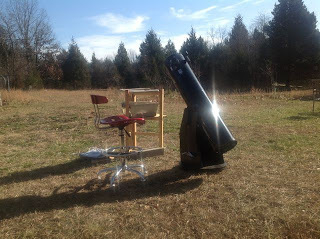 |
| My scope, chair and work stand with EP case. |
This is for a budget of about $600. For most beginners I would suggest going with an 8" dobsonian that will run about $360 If you are at all interested in looking at fainter objects such as the Messier or Herschel objects this would be the minimum size. Many of the faint objects would be visible in a 6" but would be very difficult. There's nothing wrong with a challenge of course but even with the 8" scope that I have they are difficult. Most of these are distant galaxies and planetary nebula and while it is expected that they would be very faint and small I think 8" is the cutoff for seeing something that is actually worth seeing. My scope, purchased in September 2012 from Orion, is the XT8.
A note about mounts. Dobsonians are ground mounted newtonian reflector scopes that rely on a mirror for light gathering. They are the best choice for maximum light gathering for low cost. You can get a tripod mounted reflector but in my opinion the Dobsonian is the easiest to use and probably the most sturdy choice if you've got kids that will be viewing. When stored in the vertical position they don't take much space at all, about the diameter of a chair. I would avoid the tripod mounted refractor scopes often sold in department stores. They use an optical lens for light gathering and will be much smaller in diameter giving you much less light gathering.
Something to consider at this point is your local light pollution. If you are in a city or suburbia with lots of light pollution you'll be much more limited in what you can see. In this case the fainter objects will be more difficult to find. If you are more distant from light pollution, say 10 minutes outside of a small town or 45 minutes outside of a large city, you probably have darker skies and in that case a larger scope would be worth the money. Here's a map of light pollution in the U.S. You can find a larger version via Bing or Google. Some folks that are in cities buy a scope knowing that they will travel to a dark sky site every so often.
If your primary interest is our solar system's planets and the moon the 6" will serve you well. That said, you only really get to see any detail with Jupiter and Saturn. The other planets only resolve to tiny disks/dots and won't have much detail. In my opinion you'll have a much longer term interest in amateur astronomy if you go with an 8" and learn to find and appreciate the faint objects in the lists above. Learning to star hop is kind of like reading the stars and for me has been a very gratifying, fun and interesting process.
 |
| Eye pieces and filters sitting on heating pad in case |
To give you an idea of useful magnifications here's what I've got: 26mm (good for large objects such as Orion's Nebula and the Andromeda Galaxy); 18mm which gives you a nice step up to a more magnified view of objects; 11mm (my next purchase) is the next step up for a great view of Saturn and Jupiter as well as some of the fainter galaxies; 5mm gives the most magnified view of Jupiter and Saturn. The problem with higher magnification EPs such as the 5mm is that you have to have the very best atmospheric conditions to use it. Many nights it won't be useful at all and will give you a very fuzzy image. There will be many nights though that have good seeing conditions and on those nights you'll get a fantastic view of the clouds of Jupiter and rings of Saturn. Also, it is with these higher magnification EPs where the wider field of view becomes much more useful because it makes finding the object easier and keeps it in the field of view longer.
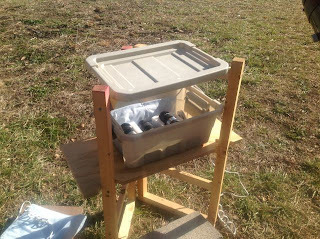 |
| Home made workstation. The case lid is held in place by several screws on the top tier. Second heating pad is put there with laptop on top for recording observations directly into database. |
Just a quick edit to address an important point brought up by @Bas Waanders over on Google+ which is that what you'll see through an amateur telescope is a far, far cry from the images you see on the internet!! The human eye has a very limited ability to gather color in such low light so most of what you will see is gray scale. You won't get nearly the detail and most galaxies, especially the very distant ones are just faint smudges. With a lot of practice your eyes do become much better at seeing some of the detail but don't buy a scope expecting the epic detail and color via the images you've seen as they are many stacked 30 second exposures. That said, some objects are truly fantastic in a small scope, for example the Orion Nebula is stunning even without the color. Also, the Eagle and Lagoon Nebulas and quite a few of the globular clusters. Andromeda looks pretty good too though does not have the color or detail from images.
Geminids and Galaxies
During the course of the evening I looked at 17 galaxies, 1 globular cluster and easily 100+ meteors. I was looking through the scope most of the night but in the short times I was looking up with just my eyes I would easily see 1-3 a minute sometimes more or less, depending on the time of night.
All together, about 9 hours looking up :)
Finding Bliss in the Universe
Between the moon at the first of the month and the nearly constant cloudiness it’s been hard getting any kind of extended time at the scope. Last night was fantastic and it looks like the forecast for the next 2-3 nights looks great.
 |
| M81 and M82 |
I’ve always, as long as I can remember, taken note of and appreciated the stars in the night sky. Today, at 43, I can say that I truly understand who and what I am in this universe. Well, I more fully understand. True understanding is just the goal of the process. To be a living being on this beautiful planet, just one of many trillions of planets in the universe, is so amazing. I sometimes feel a bit guilty that I am able to experience such bliss in my life. Wether walking in the woods or looking up at the stars, leading such a simple life and being a part of the greater universe, I can ask for nothing more.
And about last night’s viewing session? I was happy to view thirteen more objects in the Herschel 400 as well as a swing by the two galaxies known as Bode’s Nebulae and a quick view of the Double Cluster in Perseus! Last but not least, Jupiter. I probably spent twenty minutes looking at Jupiter and I have to say, it never get’s old. Each time, each moment, is breath taking. On a good night such as last night, the 5mm EP is fantastic for viewing this beautiful neighbor of ours. The cloud bands and the GRS are crisp and easy to see. Wonderful.
As I spend more time outside at night I am consistently seeing more with my naked eyes, especially on nights with good seeing. Last night, at various points between looking through the EP, I really made it a point to enjoy the naked eye view. In particular, I spent some time gathering up the faint stars and the fuzzy Messier objects. For example, the Beehive Cluster in Cancer was so easy and obvious to see. In fact, I wasn’t even looking for it but was just scanning the sky and it stood out to me. The Double Cluster in Perseus was also an obvious and easy to see object with the naked eye.
A special note about Bode’s Nebulae: What a sight to see them together in one eyepiece! At 11 million light years distance, M81 offers a face view and is interacting with M82 which is a prototype starburst galaxy presenting an elongated view. After weeks of focusing mostly on small and faint galaxies and clusters, anytime I come upon the more easily seen objects I always find myself surprised at just how beautiful and defined they are! These two are a great example of that. I have no doubt that it is just the slow improvement of my viewing skills and my greater awareness of the range of faint objects.
Fire in the sky
 |
| Image of NGC 7331 and companions |
As far as viewed objects, a few open clusters that were not all that impressive (in part due to the poor atmospheric conditions) as well as three galaxies that were viewed first and were much better thanks to better conditions earlier on. It is amazing how quickly the viewing can change based on humidity, light clouds not often obvious as clouds but there nonetheless.
The best view of the night was NGC 7331. While I was not able to see the small companion galaxies NGC 7331 was very nice.
Also, a note about the images I use. They're not mine and are almost aways taken from Wikipedia. Though they often seem unreal, like paintings, they are not. They are actual images though in almost all cases there is a good amount of processing as is required by astrophotography. Multiple exposures are sometimes layered, color is added, enhanced or balanced, etc.
Dancing with the clouds
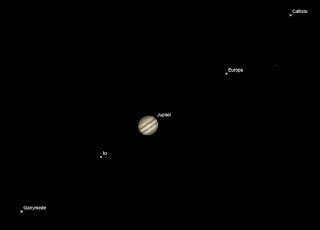 |
| Image of Jupiter from SkySafari |
Normally, I would not have bothered with such a mixed night but we've had 10 days of pretty cloudy weather and with a few clear nights blotted out by the moon. I was desperate.
 |
| Sigma Orionis |
Couple hours later, about 10:30pm, I saw Karen post on the FB about being outside viewing so I went out: totally clear. Curse words. Get eyepieces and make a dash for the telescope. Set-up. Sit down. Clouds. More curse words. Wait. Look around. Decide there is enough clear sky to stay out. I spent the next 2 hours, maybe 3 hopping away from clouds, trying to find a few things before being foiled. Lesson learned? If you're desperate and willing to dance with the clouds for awhile, there might be a reward.
I got a fantastic view of Jupiter in the 5mm EP. The cloud bands were crystal clear and I was able to easily make out 3-4 bands. Unfortunately no GRS as it was on the other side of the planet. I also had a good viewing of a couple of planetary nebula. NGC 1535, Cleopatra's Eye, was particularly good. It is a bright blue sphere and with the 5mm EP a bright central core is easily visible. Of course the moon was out so anything faint was out of the question. I ended the night with a great shot of Sigma Orionis, a 5 star (only 4 viewable) system in Orion. Not my photo but this is exactly what I saw. Very cool.




